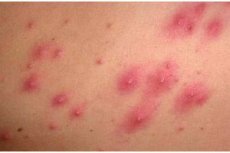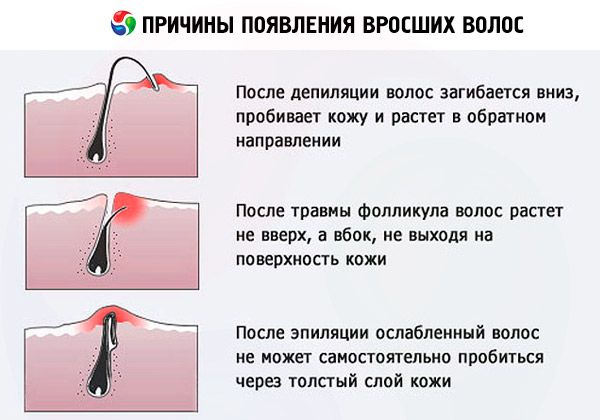Medical expert of the article
New publications
Ingrown hair after waxing: causes, remedies and prevention
Last reviewed: 05.07.2025

All iLive content is medically reviewed or fact checked to ensure as much factual accuracy as possible.
We have strict sourcing guidelines and only link to reputable media sites, academic research institutions and, whenever possible, medically peer reviewed studies. Note that the numbers in parentheses ([1], [2], etc.) are clickable links to these studies.
If you feel that any of our content is inaccurate, out-of-date, or otherwise questionable, please select it and press Ctrl + Enter.

Ingrown hairs after epilation are one of the most common problems. They appear when hair is not completely removed during epilation or depilation - some remains under the skin, continuing to grow.
Causes ingrown hairs after waxing
Usually, ingrown hairs occur as a result of hair removal performed at home, but sometimes such a problem appears after a salon procedure. In order to know how to get rid of ingrown hairs, you should first find out the reasons why this happens. Cosmetologists believe that this problem largely depends on the density of the skin, as well as the number of its layers.
Reasons that provoke ingrown hairs:
- Dense layer of skin;
- Hormonal imbalance (in the first half of the menstrual cycle there is a surge in estrogen). Such changes can also occur due to a disruption in the endocrine system, and in addition to this, an increase in the rate of estrogen production;
- Trauma to the hair canal during the epilation procedure;
- The appearance of a microscopic scar in the hair canal after the procedure;
- Breaking or damaging a hair below the skin level, which is possible if epilation is performed incorrectly;
- Shaving against the grain, especially when done with a dull razor;
- Tight or uncomfortable underwear (especially synthetic), which prevents sweat from evaporating from the skin and often causes bacterial infection. Synthetic underwear is not recommended to be worn immediately after the procedure, so as not to cause inflammation.

Risk factors
Most often, this problem is faced by those with overly sensitive and thin skin, as well as girls with overly thick and rough skin. Another risk factor is dry skin, which was additionally overdried by tanning (including artificial tanning in a solarium).
Symptoms ingrown hairs after waxing
Among the first signs of the problem is the appearance of local redness on the epidermis, which looks like a large rash. In the worst case, when hair grows in, boils form on the skin, which begin to become inflamed.
Complications and consequences
What are the dangers of ingrown hairs after epilation? Consequences and complications
Ingrown hairs can cause quite dangerous complications:
- They can lead to the development of an inflammatory process with subsequent suppuration - this can be the beginning of an infectious infection;
- After hair removal, various scars, marks or spots similar to pigmentation may remain on the surface of the epidermis, and it is possible that they will become quite large and noticeable.
 [ 1 ]
[ 1 ]
Who to contact?
Treatment ingrown hairs after waxing
The problem can be solved using the following methods:
If the hair is not deep and there is no inflammation on the skin, it is necessary to steam it, then perform a light peeling, using a scrub. If there is no scrub, you can take a hard washcloth or a special synthetic glove. It may not be possible to completely free the ingrown hairs, but with your actions you will still clear their path to the surface. Such peeling is allowed to be done daily or every other day, softening the skin after the procedure - use any moisturizing cream or choose a lotion.
If there is inflammation, you need to apply any acne-removing medication to the affected area for some time. When the inflammation subsides, you can perform a light peeling procedure.
If the hairs are located too deep, this is determined by the thickening of the skin in this area, as well as slight redness of this place. In this situation, the hairs must be removed mechanically - using a medical needle and tweezers. But it is not recommended to remove them yourself - it is better to leave this procedure to a specialist.
If you do not have such an opportunity, you need to steam the area of inflammation, taking a simple wet warm compress, and then treat it using an antiseptic. Next, take a sterile medical needle, carefully pick up the hair with it, and grab it with tweezers. Then you need to treat this place again with an antiseptic, and then apply a cooling compress to it.
Remedies for ingrown hairs after epilation
There are many different products that can help combat ingrown hairs after hair removal.
Levomekol ointment improves the tissue regeneration process and also has an excellent antibacterial effect. With its help, you can remove hairs and quickly heal the wounds left behind. You need to apply the ointment to gauze and apply it to the damaged area for several hours. This procedure can be repeated every day until the hair is removed.
Salicylic acid is applied to the inflamed areas until the hairs are on the surface of the skin. Since this product is an antiseptic, you will protect yourself from possible infection.
In addition, it is allowed to use special products for treatment that help remove ingrown hairs. Almost any cosmetic company has such products in their cosmetic lines. There are local ointments that help soften the skin, as well as the growth of hair through it. Products produced by Folisan cope with such problems quite effectively.
There are also lotions - for example, Ingrow Go from Skin Doctors, and in addition to this, Aravia Professional or Depilflax, as well as other products that have disinfecting, drying, and also pulling properties, which helps hairs come to the surface without difficulty. These lotions are quite cheap, and one such bottle will last a long time. They can be applied after each epilation - as a preventive measure against possible ingrowth.
Creams for ingrown hairs after epilation
The skin requires regular moisturizing - various creams are used for this. In case of ingrown hairs, greasy creams should not be used as a moisturizer, as they can clog pores. More suitable would be regular preparations containing natural substances.
Folk remedies
There are also folk remedies.
A lotion that is prepared as follows effectively helps to cope with the problem: take 2 tablets of aspirin, 1 teaspoon of glycerin, and ¼ cup of boiled water and mix these ingredients to form a healing mixture. Wipe the areas with ingrown hairs with this lotion several times a day. Soon they will grow to the surface themselves.
Take some bodyagi powder and mix it with a small amount of hydrogen peroxide to get a mixture that is neither thick nor liquid. It must be applied to the damaged area and left for 10 minutes. After the procedure, wash off the mixture and lubricate the treated area with either olive oil or regular baby cream. This procedure must be carried out every day for a week.
Mix 2 tablespoons of cane sugar and 1 tablespoon of jojoba oil (or olive oil), and add 10 drops of melaleuca oil. The resulting scrub will help exfoliate hardened skin cells, and in addition, it will have an antiseptic and softening effect on the skin.
Oil against ingrown hairs after epilation
You can remove redness and irritation from your skin using a variety of essential oils: such as jojoba, orange, almond, bergamot or frankincense oil. These products soften the skin and improve metabolic processes – this helps remove redness and spots, making your skin softer and smoother.
Herbal treatment
To remove hairs, lotions made from chamomile, calendula, and other medicinal herbs are also used. A warm, wet lotion should be applied to the inflamed area for several minutes. Such compresses should be applied for several days.
Prevention
There are several methods of preventing ingrown hairs:
- To get rid of dead skin cells, you need to do a light peeling before epilation;
- After the epilation procedure, it is necessary to soften the skin using a moisturizing cream, and also apply a product that inhibits hair growth;
- As before the procedure, after it you also need to carry out a light peeling procedure, and then repeat it at least twice a week;
- The most delicate and sensitive areas of the epidermis should be constantly treated with a solution of salicylic acid or chlorhexidine - they have mild exfoliating properties;
- To avoid causing ingrowth, it is not recommended to wear uncomfortable or tight synthetic underwear after the procedure.
Forecast
Ingrown hairs after epilation are not a health hazard and mostly cause only aesthetic discomfort. But it should be taken into account that improper removal can lead to infection and the development of purulent inflammation. Therefore, to remove hairs (especially those that have grown deep under the skin), you should seek help from specialists.

